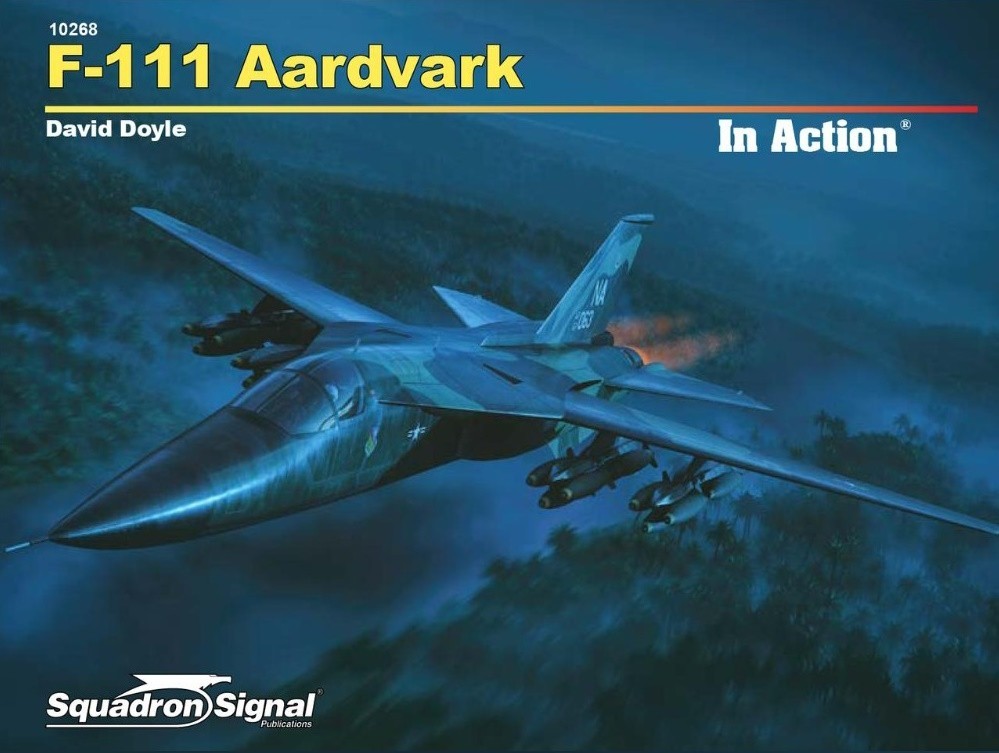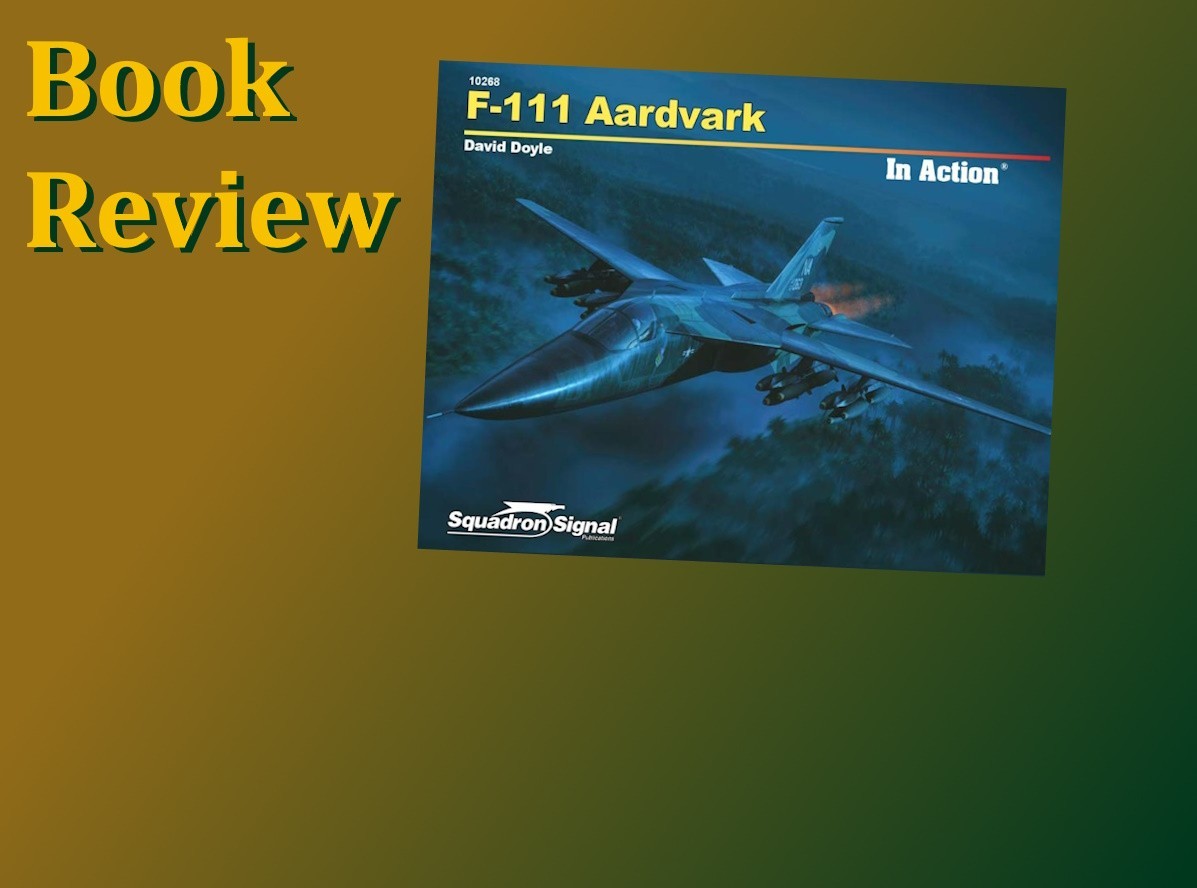
Introduction
F-111 Aardvark In Action is a new Squadron Signal Book. Authored by David Doyle, and illustrated by artists Matheu Spraggins and Piotr Forkasiewicz, this 88-page softcover book measures 11 x 0.25 x 8.5 inches and is catalogued with Squadron's SKU:SS10268, UPC:780897470025, and ISBN 978-0897478618.
For modelers and historians not of a certain age, Squadron Signal Publications have been an industry leader since their first book was published in 1971. Their original F-111 book was their 35th title of Aircraft in Action and published in the late 1970s, with 50 pages of content and a lot of black-and-white photos. As Squadron tells us;
In Action® books are books that trace the development of a single type of aircraft, armored vehicle, or ship from prototype to the final production variant. Experimental or "one-off" variants can also be included. The first In Action® book was published in 1971.
Back then the "'Vark" had cut its teeth in Vietnam and made a minor appearance in the Mayaguez incident. Operation El Dorado Canyon and Desert Storm were in the future.
When I joined USAF, the F-111 was one of my top three picks to pilot. I had a CO who flew them over North Vietnam and I looked forward to his stories - including the one about him creating an international incident within his first 10 minutes after arriving in Thailand, and his snickering about the "itty-bitty" afterburners on the F-15 and how they struggled to catch him at low altitude. Thus, as a wannabe F-111 pilot, I was very happy to learn the book has almost doubled in length with enhancements and revisions.
Content
In Action books are mainly illustrated histories. F-111 Aardvark In Action does not have a table of contents. It dives right in introducing us to the origins of the F-111, SecDef Robert Strange (an ironic name) McNamara's "switchblade Edsel." Touched upon is that McNamara wanted one airplane to do everything for both the Air Force and the Navy. That led to an infamous exclamation by an officer to a congressional committee concerning the aircraft, "There is not enough thrust in all Christendom to make the F-111 a fighter." Aside from the variable-geometry wings, the Aardvark was a very sophisticated aircraft in many other ways. Of American combat aircraft, only the F-15 was faster than it, and it's terrain-following radar gave it an amazing ability to operate all-weather and very low altitude and very high speeds. An F-111 pilot told me that he had flown supersonic through the Grand Canyon, below the rim, at night. (Something that was ended probably before the 1970s, although a F-100 pilot who got his wings in the late seventies told me about his first flight from Luke Air Force Base to Nellis ended up going through the Grand Canyon below the rim, too.)
The opening photo is a Pratt & Whitney TF30 turbofan, followed by the crew module, and a planform time-lapse showing the variable-geometry wing positions. The progression continues with photos of the first F-111, in the air and on the ground, including a bare metal F-111 in flight. Further photos show a F-111 in extreme-freezing research, and assembly line scenes. Modelers who like structural detailing may be particularly intrigued by these scenes. The author points out many interesting and useful details of markings, unusual colors, and external stores. He notes serial and Bureau numbers and other such information. Something I have never noticed before are RHAW (radar homing and warning) antennas behind the radome, and he identifies them and other sensors, i.e., vertical stabilizer HF radio antenna. Changes to avionic suites are noted.
The book continues beyond those aspects of the F-111, covering various models of the Aardvark - the A, B, C (Australia's "Pig"), D, E and F, and the FB-111 strategic bomber. Other photos focus on compartments with the panels removed, redesigned intakes, and views into intakes. A few photos show the gaps between the wings and flaps with flaps extended. Camouflage and equipment colors are identified, although not with Federal Standard numbers, presumably because the colors are so well documented and available. That is good as the F-111 wore many camouflage schemes over the decades. Such detail is excellent as it identifies yet another characteristic of the F-111 - an unfamiliar color on the EF-111 Raven electronic-countermeasures variant.
Photographs and Artwork
A terrific gallery of photos illustrates the F-111 history. The vast majority are high-quality. There are a few with color-shift, over or underexposure, or slightly fuzzy. Each page features one to four images, and if there are more on a page, I missed it. Plenty of Australian "Pigs" are pictured. Sensational photos include two of F-111s pulling a trail of fire - an popular airshow trick achieved by dumping fuel that is ignited by the afterburners.
Each image is well described with a caption. Some are basic descriptions, some provide more detail than I expected. Each caption is useful and informative.
Artwork includes:
Line art: F-111A in profile; planform (wings extended and swept); head-on. Dimensions, weights, armament, powerplants and performance are listed.
Piotr Forkasiewicz created a dramatic scenes:
1. F-111 low over the Vietnamese jungle
2. El Dorado Canyon F-111 releasing a bomb while an Il-76 "Candid" explodes behind it.
Artist Matheu Spraggins created the following profiles:
A. F-111A 63-9766, Developmental Test & Evaluation aircraft.
B. USN F-111B, Bureau Number 151972.
C. USAF/NASA 'Vark used to test a supercritical wing.
D. EF-111A.
E. F-111A 67-0072, Det 1, 428th Tactical Fighter Squadron (TFS), Takhili Royal Thai Air Force Base, 1973.
F. F-111D 68-0111, City of Portales.
G. FB-111A 68-0248, in SAC bomber colors.
H. F-111F, 70-428, in all-gray scheme.
I. F-111F with a white radome.
Overall, the images are worth acquiring this book.
Conclusion
Squadron's revival and improvement of the In Action® series is very much appreciated, and F-111 Aardvark In Action is a great example of their enhancement. Between the text and images, it provides modelers with a terrific resource for the Aardvark.
I look forward to the my next new Squadron Signal In Action book and happily recommend F-111 In Action.
Please remember to mention to Squadron and retailers that you saw this product here - on Aeroscale.

